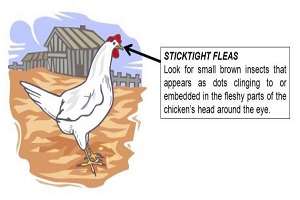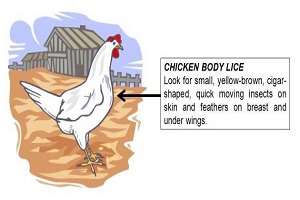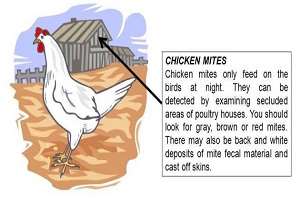Figure 2. Where to look for scaly-leg mites. Created by Jacquie Jacob, University of Kentucky.
Scaly-leg mites (Knemidokoptes mutans) are smaller than the northern fowl mite (1/100th of an inch) and live under the scales on birds' legs and feet. These mites are pale gray and have flat, circular bodies. Scaly-leg mites burrow under chickens' leg scales and feed on the tissue under the scales. The legs of an infected bird get thick and crusty. In severe cases the blood supply to the toes may be cut off, and the bird may lose toes.
Infected birds can be treated with Ivermectin. In addition, coating the entire leg with petroleum jelly or dipping the legs in linseed oil will help to suffocate the mites and moisturize the scales. Although scaly-leg mites prefer to live on birds, these mites can survive in the poultry house. It is therefore important to treat the inside of the poultry house, making sure the nesting area, roosts, and any cracks and crevices are treated.
The legs of a chicken that has had a mild case of scaly-leg mites will eventually return to normal. However, in more severe cases, the swollen and deformed look to the feet may remain. Exhibition birds that have legs deformed by mites should not be shown.
Sticktight Fleas

Figure 3. Where to look for sticktight fleas. Created by Jacquie Jacob, University of Kentucky
Sticktight fleas (Echidnophaga gallinacea) attach themselves to the skin and wattles on the head of birds. Unlike northern fowl mites or scaly-leg mites, these fleas can thrive on other animals, including dogs, cats, horses, and humans.
Female sticktight fleas forcefully eject eggs into the surrounding environment. Larvae develop in the soil around poultry houses. It typically takes four weeks for an egg to develop into an adult. Adults are free-living until it is time to breed, at which time female fleas attach to the skin around the face and wattles and lay their eggs to continue the cycle.
Sevin dust can be applied to exposed fleas and litter. Attached fleas will die within a short period of time, but they may remain attached for several days or weeks. An alternative method for treating a sticktight flea infestation is to coat exposed adult fleas with petroleum jelly, which suffocates the fleas. Again, even though the fleas are dead, they may remain attached for several weeks. Since such a treatment kills only the adult females, it is necessary to repeat the treatment weekly to catch any additional fleas that may have developed. In addition, it is important to treat the poultry pen by using an approved insecticide on the litter or by replacing the old litter with clean bedding.
Poultry Lice

Figure 4. Where to look for chicken body lice. Created by Jacquie Jacob, University of Kentucky.
There are two kinds of lice: biting and blood sucking. Blood-sucking lice attack only mammals, but biting lice infect both birds and mammals. Poultry lice are species-specific and cannot survive on humans.
The chicken body louse (Menacanthus stramineus) and the shaft louse (Menopon gallinae) are the two species of lice most commonly found on poultry. Lice lay their eggs on the birds' feathers, typically near the base of the feather shaft. The eggs are cemented together and so have the appearance of a collection of white particles. After hatching, lice may live on a bird for several months; however, they can survive off the bird for only one week. The entire life cycle of the lice occurs on the host bird, primarily in the feathers.
Lice that infect poultry do not suck blood; instead, they feed on dry skin scales, feathers, and scabs. They will, however, feed on any blood that appears on the skin surface. Infested birds may appear agitated because of the skin irritation. They will have damaged feathers and will appear to be in general poor health. Infested flocks may also show reduced feed intake, slowed body growth, decreased fertility, and declining egg production. Young birds are usually more seriously affected than are adult birds.
Insecticides that treat northern fowl mites will also control lice. Generally, lice do not leave the host bird unless they are moving to another bird, so careful treating of the birds' environment isn't as crucial as it is with the other external parasites. Nevertheless, it is important to treat the environment. The time from egg to adult for lice is about three weeks, so repeated treatments are required.
Chicken Mites

Figure 5. Where to look for chicken mites. Created by Jacquie Jacob, University of Kentucky
Chicken mites (Dermanyssus gallinae), also known roost mites or red mites, are found on domestic fowl around the world. These mites can also thrive on people. Symptoms of an infestation are similar to those of northern fowl mites. Unlike northern fowl mites, however, chicken mites do not live on the birds. During the day, chicken mites live in dark areas in the poultry house such as cracks and crevices in roosts, walls, ceilings, and floors. Chicken mites are nocturnal, coming out at night to feed on the birds. They are blood suckers that turn red after ingesting blood. Since chicken mites feed on the birds only at night, it may be difficult to detect a mild infestation. These gray, brown, and red mites can be detected by examining secluded areas of the poultry house. In addition to the appearance of the mites themselves, their presence may be indicated by black and white deposits of mite fecal material and cast-off skins.
Chicken mites can be transferred from wild birds, rodents, and other animals. Heavy infestations of chicken mites cause birds to have pale combs and wattles. The birds also become listless and show a decrease in egg production and male fertility; young birds experience a slowing in weight gain. Infested flocks are more susceptible to other parasites and diseases.
Effective treatment requires that treating the entire poultry house, paying special attention to the areas where these mites like to hide (every crack and crevice, as well as roosts, walls, and ceilings). The birds should also be treated with an insecticide that is approved for poultry. Be sure to read and follow all label instructions, including details regarding protective equipment the producer must wear and possible withholding time for consumption of meat and eggs from infected birds. Given the short life cycle of this parasite—7 to 14 days from egg to adulthood—it is necessary to re-treat an infected flock every 4 to 7 days. Adult mites are resistant to starvation and, when off the host, can survive without feeding for up to six months. It is important, therefore, to treat and re-treat the poultry house as well as the birds. It is also important to note that a poultry house can remain infested long after the birds have been removed.
Less-Common Parasites
Fowl ticks (Argas persicus), also known as blue bugs, are considered soft ticks. By contrast, the ticks that are normally found on cats and dogs are hard ticks. The ticks that affect birds are light reddish brown to dark brown and their skin is wrinkled. Adults are about 1/4 inch in length. Ticks live in the cracks and crevices of a poultry house. Ticks in various stages of development will feed on a host.
Females lay 50 to 100 eggs after every blood meal. Eggs are laid in the cracks and crevices in the poultry house. After the eggs hatch, the larvae seek out a host where they attach themselves and feed for four to seven days. The larvae then fall off the host and molt to the nymph stage. Nymphs and adults feed only at night and for short periods of time (15 to 30 minutes). Red spots can be observed on the bird where the tick has fed. After several nymphal molts, the adult tick emerges. The time from egg to adult is approximately 30 days.
Click here to see more...